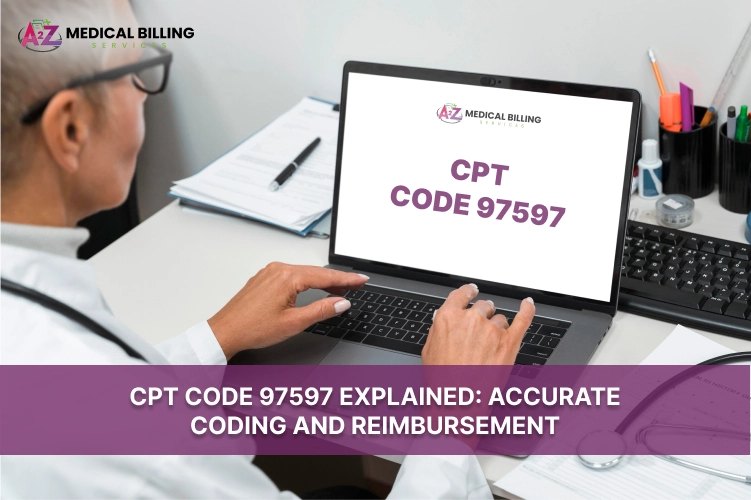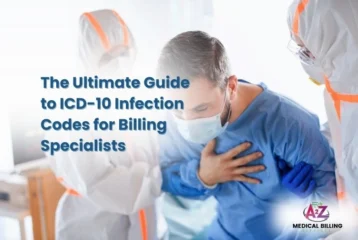CPT Code 97597 refers to the selective debridement of open wounds, which involves the removal of devitalized, necrotic, or non-viable tissue using sharp instruments such as scalpels, scissors, or forceps. This code is used for wounds with a surface area up to 20 square centimeters.
This guideline provides a detailed insight on how to document and use the procedure code. It also significantly impacts wound care management financial and therapeutic outcomes.
97597 Full Description
Debridement (e.g., high-pressure waterjet with/without suction, sharp selective debridement with scissors, scalpel, and forceps), open wound, (e.g., fibrin, devitalized epidermis and/or dermis, exudate, debris, biofilm), including topical application(s), wound assessment, use of a whirlpool, when performed, and instruction(s) for ongoing care, per session, total wound(s) surface area; first 20 square centimeters or less.
Types of Wounds and Procedures Covered Under CPT 97597
This CPT covers selective debridement of chronic wounds (like pressure ulcers and diabetic ulcers), acute wounds (such as traumatic and surgical wounds), and infected wounds, including burns.
Types of Wounds Covered
Chronic Wounds:
- Pressure Ulcers: Wounds caused by prolonged pressure on the skin.
- Diabetic Ulcers: Non-healing wounds commonly found on the feet of diabetic patients.
- Venous Stasis Ulcers: Ulcers that occur due to poor blood circulation, often in the legs.
Acute Wounds:
- Traumatic Wounds: Injuries resulting from accidents, such as cuts, lacerations, and abrasions.
- Surgical Wounds: Post-operative wounds that require debridement to remove necrotic tissue.
Infected Wounds:
- Infected Wounds: Wounds showing signs of infection that need debridement to remove infected tissue and promote healing.
- Burns: Partial-thickness burns where debridement is necessary to remove dead skin and prevent infection.
Procedures Covered:
Selective Debridement:
- Sharp Debridement: Removal of dead, damaged, or infected tissue using scissors, scalpels, or curettes. This is a precise method targeting only necrotic tissue without affecting healthy tissue.
- Autolytic Debridement (if combined with selective methods): Use of the body’s own enzymes and moisture to rehydrate, soften, and liquefy necrotic tissue, often combined with sharp debridement.
Use of High-Pressure Waterjet:
Hydrosurgical Debridement: Application of a high-pressure waterjet to clean and remove non-viable tissue. This method can be used with or without suction to help clear the wound bed.
Topical Applications:
Application of Topical Agents: Use of substances such as antimicrobial ointments, enzymatic debriding agents, and other topical medications to assist in the debridement process and promote wound healing.
Wound Assessment:
Detailed Wound Examination: Assessing the wound for size, depth, presence of necrotic tissue, exudate, and signs of infection. Documentation of the wound’s condition before and after the debridement.
Patient Instructions:
Care Instructions: Providing patients with detailed instructions on how to care for their wounds post-debridement. This includes information on dressing changes, signs of infection to watch for, and follow-up care.
Use of Whirlpool Therapy (if applicable):
Whirlpool Debridement: Using whirlpool therapy to clean the wound and remove loose debris and necrotic tissue.
How to Use 97597 CPT Code
The 97597 code requires accurate patient documentation and supporting ICD code(s) to ensure compliance and optimal reimbursement for rendered healthcare services.
Documentation Requirements
- Wound Characteristics: Record the type, location, size (in square centimeters), and depth of the wound.
- Treatment Details: Document the method used for cleaning the wound, any medications applied, and the type of dressing used.
- Progress Notes: Update documentation in each visit to reflect changes in wound size, appearance, and response to treatment.
Accurate Billing Guidelines
- Verify Coverage: Confirm that the patient’s insurance covers the specific wound care procedures under 20 sq cm Selective Skin and Tissue Debridement.
- Use Correct Modifiers: If multiple treatments are provided, or if services are performed on different wounds, use appropriate modifiers to clarify the services billed.
- Detail Service Provided: Make sure the billing statement reflects that the wound care provided involved the removal of devitalized tissue.
Common Modifiers Used with CPT 97597
| Modifier | Description | Usage |
| -59 | Distinct Procedural Service | Indicates that the service is distinct from others billed on the same day. Used to differentiate services that are not normally reported together but are appropriate under the circumstances. |
| -25 | Significant, Separately Identifiable Evaluation and Management Service by the Same Physician on the Same Day of the Procedure or Other Service | Apply when a significant and separately identifiable E/M service is performed on the same day as the debridement. |
| -51 | Multiple Procedures | Use when multiple procedures are performed during the same session by the same provider. It helps to adjust the reimbursement for secondary procedures. |
| -XS | Separate Structure | Specifies that the service was performed on a separate anatomical structure or organ system, distinct from other services performed on the same day. |
97597 Code: Challenges, Impact, and Solutions for RCM
Common obstacles and strategic solutions associated with 97597 wound care CPT code, enhancing both billing accuracy and compliance.
Common Coding Errors
Some common typical mistakes made when coding includes
- Incorrect Wound Size Documentation: Incorrect documentation to accurately measure and record the wound size can lead to wrong coding.
- Misidentification of Tissue Type: Incorrectly identifying the type of tissue removed during the procedure affects the applicability.
- Overlapping Services: Billing 97597 with other codes that cover aspects of the service already included.
Impact of These Errors:
Following are the impacts of coding errors that leads to
- Billing Delays and Denials: Errors in coding can lead to claim rejections and payment delays, requiring additional administrative work to correct.
- Compliance Risks: Misuse of CPT codes can result in audits and penalties, impacting the healthcare provider’s compliance record.
Best Practices for Accuracy
Tips and Best Practices for ensuring accurate Coding and optimized reimbursement.
- Thorough Documentation: Always ensure a detailed recording of the wound’s dimensions, location, and the specific tissue types involved.
- Regular Training: Keep staff updated on the latest coding standards and changes specific to wound care coding.
- Use of Coding Tools: Employ updated electronic medical record (EMR) systems that prompt for necessary details and can help in preventing common coding errors
- Clear Communication: Maintain clear communication between the clinical team and coders to ensure all relevant procedural details are accurately captured.
Let’s Recap
Understanding and accurately using CPT Code 97597 for selective skin and tissue debridement up to 20 sq cm is crucial for effective wound care management. Proper documentation, precise coding, and adherence to billing guidelines ensure optimal reimbursement and compliance. By following best practices, healthcare providers can improve compliance, reduce billing errors, and support better patient care outcomes.
FAQs
97597 procedure code is utilized for the selective debridement of open wounds, which involves removing devitalized, necrotic, or non-viable tissue using sharp instruments such as scalpels, scissors, or forceps. This code applies to wounds with a total surface area of up to 20 square centimeters
Yes, it can be billed for multiple wounds as long as the total surface area of the debrided tissue does not exceed 20 square centimeters. For additional debridement beyond this area, the add-on code 97598 should be used
CPT 97597 is used for the initial 20 square centimeters or less of selective debridement of open wounds, involving procedures. In contrast, CPT Code 97598 is an add-on code for each additional 20 square centimeters (or part thereof) of debridement beyond the initial area covered by 97597.
The Medicare reimbursement rate for 97597 code, which covers the selective debridement of open wounds up to 20 square centimeters, is determined by the Relative Value Units (RVUs) and the conversion factor.
Accurate documentation should include a detailed wound assessment, the debridement technique used, the extent and type of tissue removed, the size and location of the wound, and any topical applications or instructions for ongoing care provided during the session.



